engine TOYOTA HIGHLANDER HYBRID 2012 XU40 / 2.G Owners Manual
[x] Cancel search | Manufacturer: TOYOTA, Model Year: 2012, Model line: HIGHLANDER HYBRID, Model: TOYOTA HIGHLANDER HYBRID 2012 XU40 / 2.GPages: 636, PDF Size: 11.26 MB
Page 534 of 636

534 5-2. Steps to take in an emergency
■Changing the engine oil (U.S.A. only)
Make sure to reset the oil change system. ( P. 448)
■
The tire pressure warning light ma y turn on due to natural causes
The tire pressure warning light may turn on due to natural causes such
as natural air leaks or tire inflation pressure changes caused by temper-
ature. In this case, adjusting the ti re inflation pressure will turn off the
warning light (after a few minutes).
■When a tire is replaced with a spare tire
The spare tire is also equipped with the tire pressure warning valve and
transmitter. The tire pressu re warning light will turn on if the tire inflation
pressure of the spare tire is low. If a tire goes flat, even though the flat
tire is replaced with the spare tire, the tire pressure warning light does
not turn off. Replace the spare tire with the repaired tire and adjust the
proper tire inflation pressure. The ti re pressure warning light will turn off
after a few minutes.
■If the tire pressure warning system is inoperative
The tire pressure warning system will be disabled in the following condi-
tions:
(When the condition becomes normal, the system will work properly.)
●If tires not equipped with tire pressure warning valves and transmit-
ters are used.
●If the ID code on the tire pressure warning valves and transmitters is
not registered in the tire pressure warning computer.
●If the tire inflation pressure is 73 psi (500 kPa, 5.1 kgf/cm2 or bar) or
higher.
Page 535 of 636
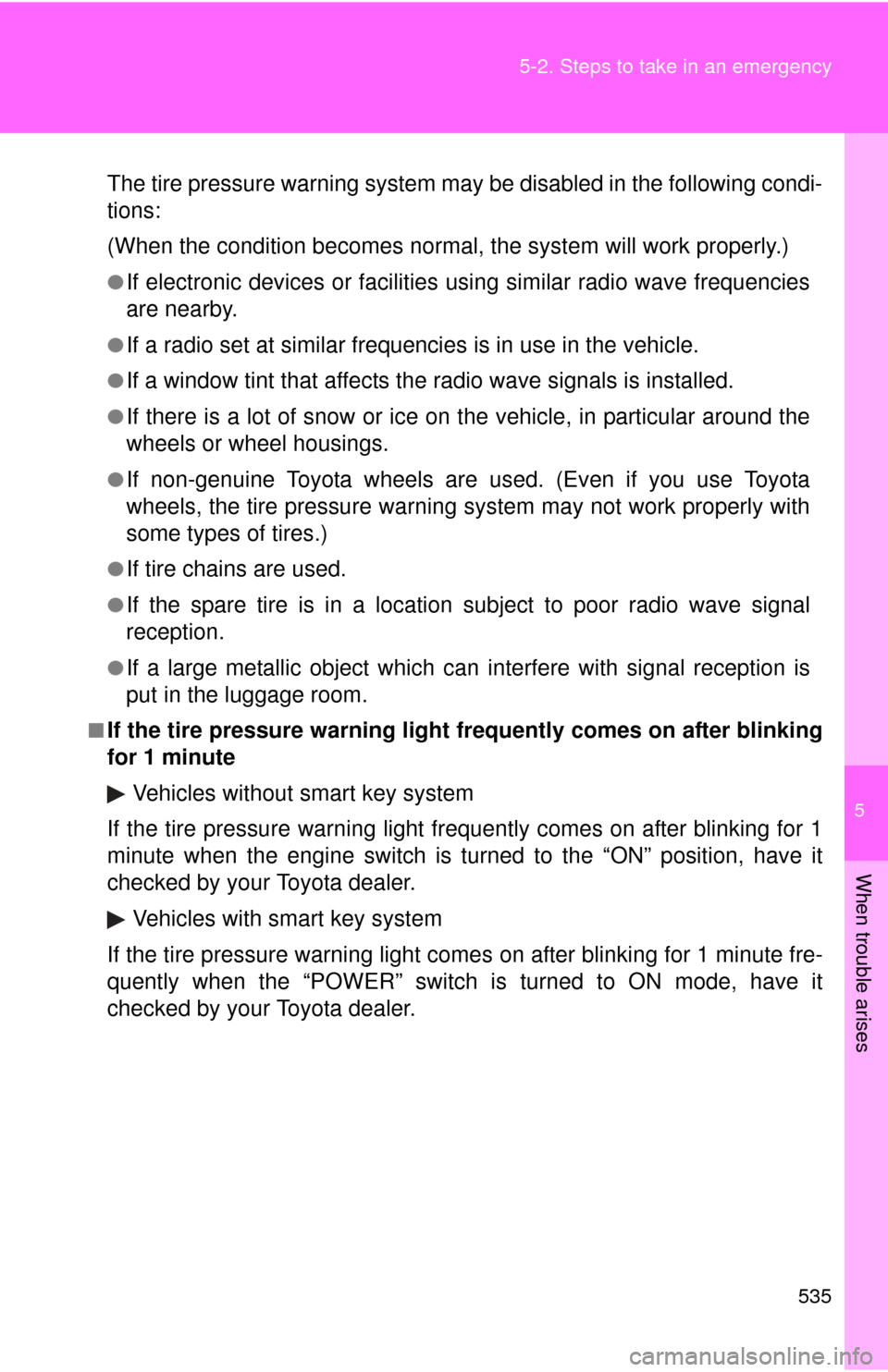
5
When trouble arises
535
5-2. Steps to take in an emergency
The tire pressure warning system may be disabled in the following condi-
tions:
(When the condition be
comes normal, the system will work properly.)
●If electronic devices or facilities using similar radio wave frequencies
are nearby.
●If a radio set at similar frequencies is in use in the vehicle.
●If a window tint that affects the radio wave signals is installed.
●If there is a lot of snow or ice on the vehicle, in particular around the
wheels or wheel housings.
●If non-genuine Toyota wheels are used. (Even if you use Toyota
wheels, the tire pressu re warning system may not work properly with
some types of tires.)
●If tire chains are used.
●If the spare tire is in a location subject to poor radio wave signal
reception.
●If a large metallic object which can interfere with signal reception is
put in the luggage room.
■If the tire pressure warning light frequently comes on after blinking
for 1 minute
Vehicles without smart key system
If the tire pressure warning light frequently comes on after blinking for 1
minute when the engine switch is turned to the “ON” position, have it
checked by your Toyota dealer. Vehicles with smart key system
If the tire pressure warning light comes on after blinking for 1 minute fre-
quently when the “POWER” switch is turned to ON mode, have it
checked by your Toyota dealer.
Page 554 of 636
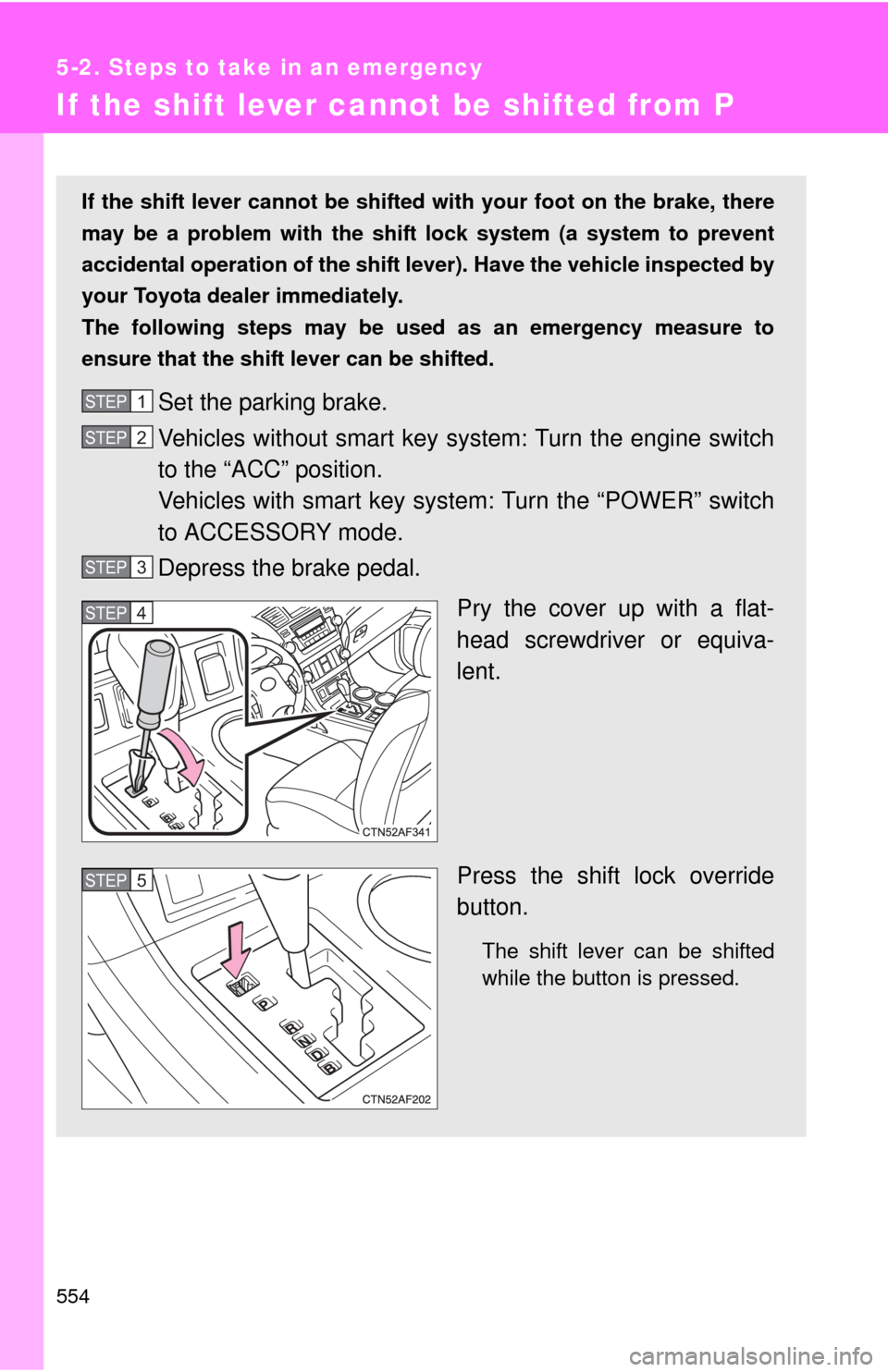
554
5-2. Steps to take in an emergency
If the shift lever cannot be shifted from P
If the shift lever cannot be shifted with your foot on the brake, there
may be a problem with the shift lock system (a system to prevent
accidental operation of the shift lever). Have the vehicle inspected by
your Toyota dealer immediately.
The following steps may be used as an emergency measure to
ensure that the shift lever can be shifted.
Set the parking brake.
Vehicles without smart key system: Turn the engine switch
to the “ACC” position.
Vehicles with smart key system: Turn the “POWER” switch
to ACCESSORY mode.
Depress the brake pedal.
Pry the cover up with a flat-
head screwdriver or equiva-
lent.
Press the shift lock override
button.
The shift lever can be shifted
while the button is pressed.
STEP1
STEP2
STEP3
STEP4
STEP5
Page 559 of 636
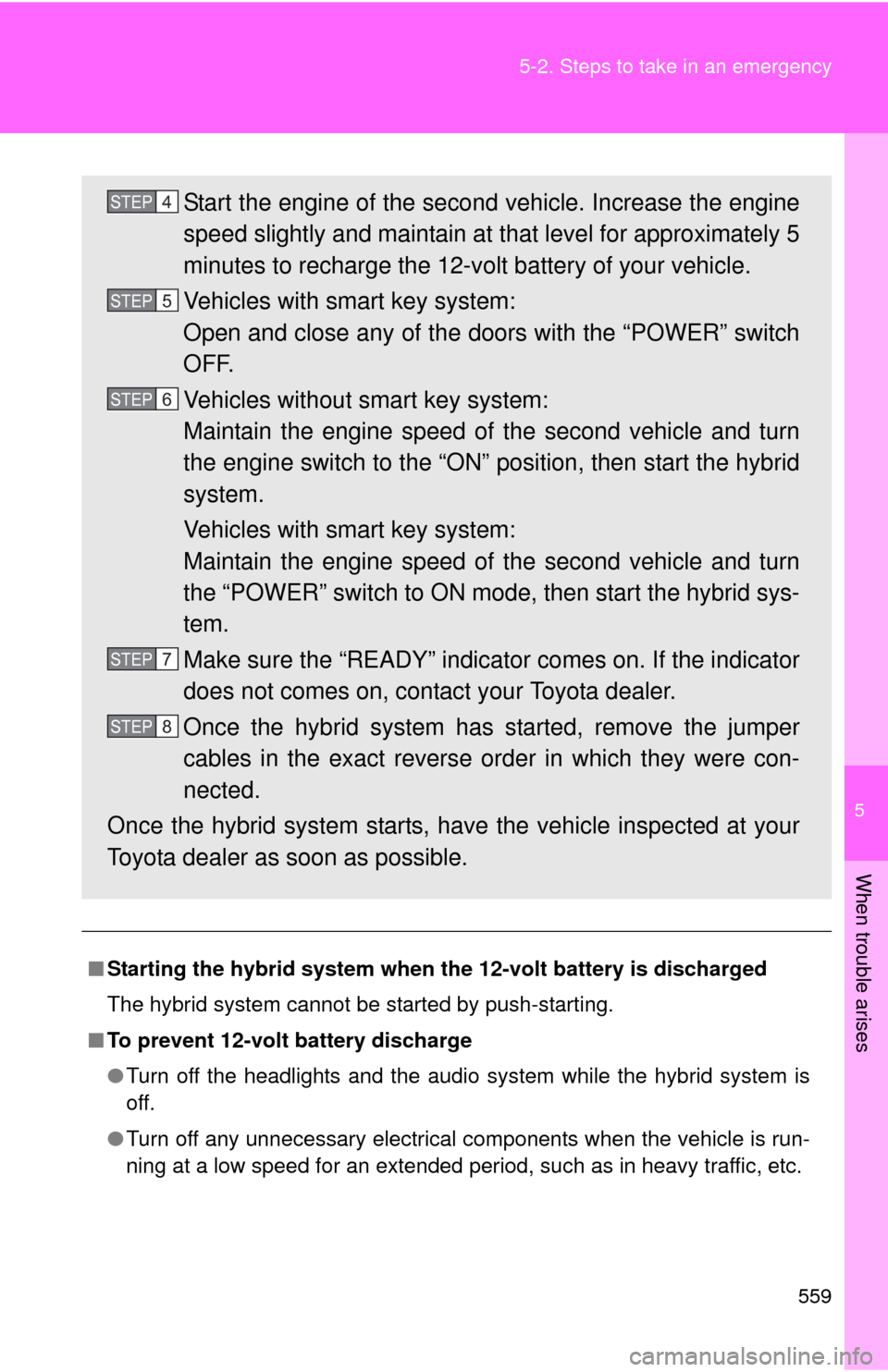
5
When trouble arises
559
5-2. Steps to take in an emergency
■
Starting the hybrid system when the 12-volt battery is discharged
The hybrid system cannot be started by push-starting.
■ To prevent 12-volt battery discharge
●Turn off the headlights and the audio system while the hybrid system is
off.
● Turn off any unnecessary electrical components when the vehicle is run-
ning at a low speed for an extended period, such as in heavy traffic, etc.
Start the engine of the second vehicle. Increase the engine
speed slightly and maintain at that level for approximately 5
minutes to recharge the 12-v olt battery of your vehicle.
Vehicles with smart key system:
Open and close any of the doors with the “POWER” switch
OFF.
Vehicles without smart key system:
Maintain the engine speed of the second vehicle and turn
the engine switch to the “ON” position, then start the hybrid
system.
Vehicles with smart key system:
Maintain the engine speed of the second vehicle and turn
the “POWER” switch to ON mode, then start the hybrid sys-
tem.
Make sure the “READY” indicator comes on. If the indicator
does not comes on, contact your Toyota dealer.
Once the hybrid system has started, remove the jumper
cables in the exact reverse order in which they were con-
nected.
Once the hybrid system starts, ha ve the vehicle inspected at your
Toyota dealer as soon as possible.STEP4
STEP5
STEP6
STEP7
STEP8
Page 562 of 636

562
5-2. Steps to take in an emergency
If your vehicle overheats
Correction procedures■ If the needle of the engine coolant temperature gauge enters
the red zone
Stop the vehicle in a safe place and turn off the air condition-
ing system.
Check to see if steam is coming out from the engine area.
If you see steam:
Stop the hybrid system. Carefully lift the hood after the
steam subsides and then restart the hybrid system.
If you do not see steam: Leave the hybrid system operating and carefully lift the
hood.
Check if the cooling fans are operating.
If the fans are operating: Wait until the engine coolant temperature gauge begins to
fall and then stop the hybrid system.
If the fans are not operating: Stop the hybrid system immediately and call your Toyota
dealer.
The following may indicate that your vehicle is overheating:
●The needle of the engine coolant temperature gauge enters the
red zone:
The engine may be overheating.
● “Hybrid System Overheat” is shown on the multi-information dis-
play:
The power control unit may be overheating.
Follow the correction procedure as described below.
STEP1
STEP2
STEP3
Page 563 of 636
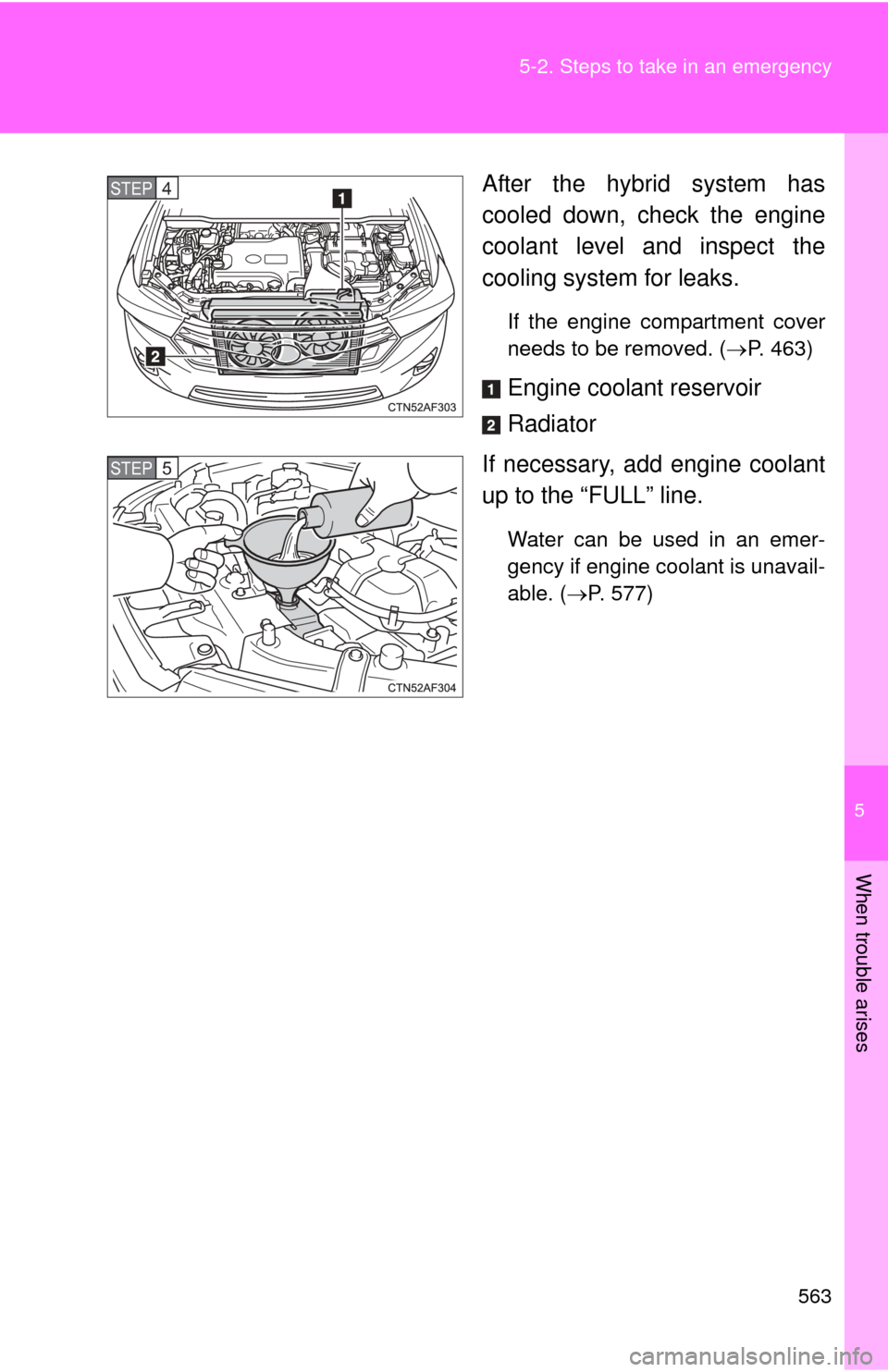
5
When trouble arises
563
5-2. Steps to take in an emergency
After the hybrid system has
cooled down, check the engine
coolant level and inspect the
cooling system for leaks.
If the engine compartment cover
needs to be removed. (
P. 463)
Engine coolant reservoir
Radiator
If necessary, add engine coolant
up to the “FULL” line.
Water can be used in an emer-
gency if engine coolant is unavail-
able. ( P. 577)
STEP4
STEP5
Page 564 of 636
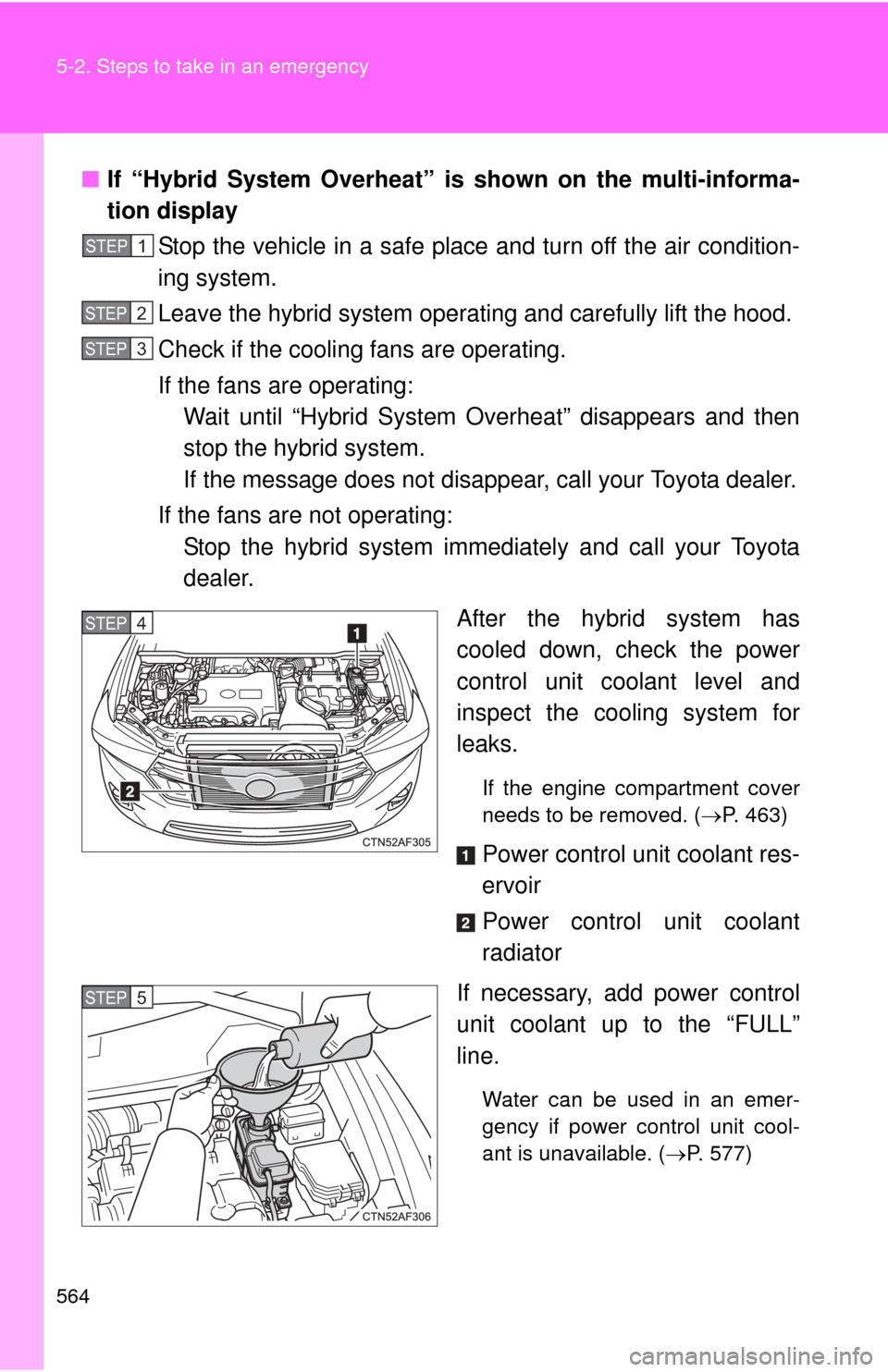
564 5-2. Steps to take in an emergency
■If “Hybrid System Overheat” is shown on the multi-informa-
tion display
Stop the vehicle in a safe place and turn off the air condition-
ing system.
Leave the hybrid system operating and carefully lift the hood.
Check if the cooling fans are operating.
If the fans are operating: Wait until “Hybrid System Overheat” disappears and then
stop the hybrid system.
If the message does not disapp ear, call your Toyota dealer.
If the fans are not operating: Stop the hybrid system immediately and call your Toyota
dealer.
After the hybrid system has
cooled down, check the power
control unit coolant level and
inspect the cooling system for
leaks.
If the engine compartment cover
needs to be removed. (P. 463)
Power control unit coolant res-
ervoir
Power control unit coolant
radiator
If necessary, add power control
unit coolant up to the “FULL”
line.
Water can be used in an emer-
gency if power control unit cool-
ant is unavailable. ( P. 577)
STEP1
STEP2
STEP3
STEP4
STEP5
Page 565 of 636
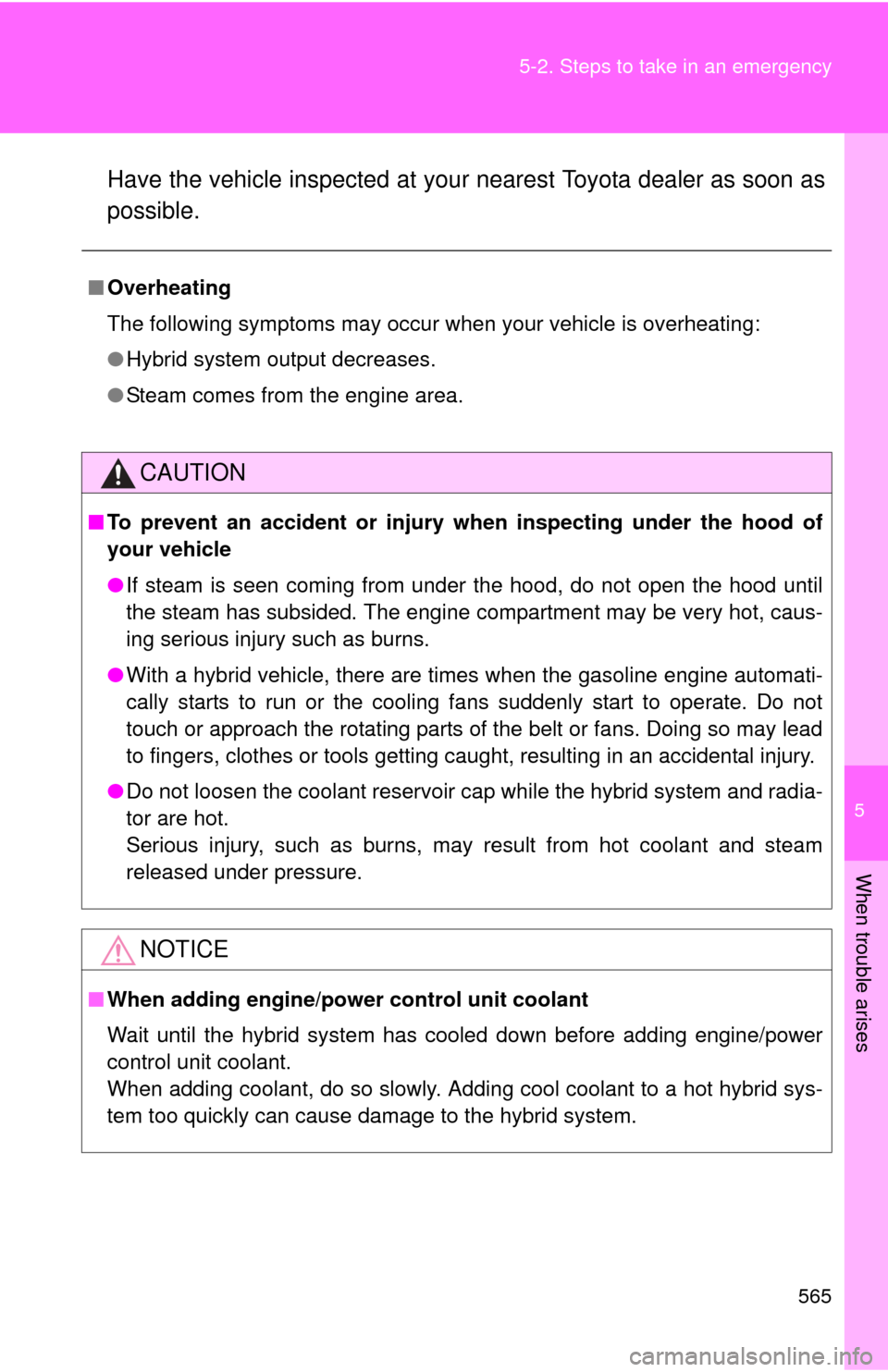
5
When trouble arises
565
5-2. Steps to take in an emergency
Have the vehicle inspected at your
nearest Toyota dealer as soon as
possible.
■ Overheating
The following symptoms may occur when your vehicle is overheating:
●Hybrid system output decreases.
● Steam comes from the engine area.
CAUTION
■To prevent an accident or injury when inspecting under the hood of
your vehicle
●If steam is seen coming from under the hood, do not open the hood until
the steam has subsided. The engine compartment may be very hot, caus-
ing serious injury such as burns.
● With a hybrid vehicle, there are times when the gasoline engine automati-
cally starts to run or the cooling fans suddenly start to operate. Do not
touch or approach the rotating parts of the belt or fans. Doing so may lead
to fingers, clothes or tools getting caught, resulting in an accidental injury.
● Do not loosen the coolant reservoir cap while the hybrid system and radia-
tor are hot.
Serious injury, such as burns, may result from hot coolant and steam
released under pressure.
NOTICE
■When adding engine/power control unit coolant
Wait until the hybrid system has cooled down before adding engine/power
control unit coolant.
When adding coolant, do so slowly. Adding cool coolant to a hot hybrid sys-
tem too quickly can cause damage to the hybrid system.
Page 567 of 636

5
When trouble arises
567
5-2. Steps to take in an emergency
If your vehicle has to be stopped in an emergency
Only in an emergency, such as if it becomes impossible to stop the
vehicle in the normal way, stop the vehicle using the following pro-
cedure:
Steadily step on the brake pedal with both feet and firmly
depress it.
Do not pump the brake pedal repeatedly as this will increase the
effort required to slow the vehicle.
Shift the shift lever to N.
If the shift lever is shifted to N After slowing down, stop the vehi cle in a safe place by the
road.
Stop the hybrid system.
If the shift lever cannot be shifted to N Keep depressing the brake pedal with both feet to reduce
vehicle speed as much as possible.
Vehicles without a smart key
system: Stop the hybrid sys-
tem by turning the engine
switch to the “ACC” position.
STEP1
STEP2
STEP3
STEP4
STEP3
STEP4
Page 572 of 636

572 6-1. Specifications
■Certification Label
This number is also on the Certi-
fication Label on the driver’s side
center pillar.
■ Engine number
The engine number is stamped
on the engine block as shown.